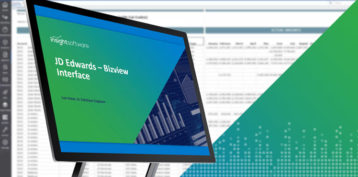Five Key Questions to Help Speed JD Edwards Financial Reporting

While JD Edwards transactional data is required to run period close reports, analyze trends, and prepare forecasts for planning and budgeting, it comes with a lot of complexity. JD Edwards EnterpriseOne includes more than 5,000 tables of data in total and over 2,100 of those support just its business applications. Each table can be huge. In one case, of 570GB of data in production, about half the data (260GB) was found in only 8 tables. Its Account Ledger was 100GB with 35 million rows! Knowing how to identify data in those tables and being able to quickly get the right data when you need it is all part of the headache you face when trying to meet financial reporting deadlines.
Ready to Navigate Financial Reporting in JD Edwards with Ease?
View Whitepaper NowAccording to a recent survey by the Hackett Group, 90 percent of finance respondents rated improving enterprise data and analytics capabilities as highly important or even critical. They pointed out the need for analytics to improve business insights in a fast-changing economic environment. But how can finance departments provide this kind of information at speed? To help sort this out, we’ve outlined five key questions to ask yourself regarding your reporting that might help reduce your stress and speed JD Edwards reporting processes.
1 – What are all your reporting needs?
Financial reporting on JD Edwards data covers a lot of ground. In addition to period closes, your finance team might need to run reports such as Margin Analysis, Cash Flow Modeling, Customer Profitability Analysis, Sub-Ledger Reconciliation, Financial Consolidation, Project Management Reporting, As-of Inventory, and Sales Reporting. How are your reports accessing the required JD Edwards data today? Do you depend on IT or power users to do this for you? Not having direct access to the data you need hinders your ability to deliver on-demand reporting.
- Do you need to provide visualizations to help other departments manage their costs and expenses?
- Do you need to provide better visibility into bottlenecks that are affecting business performance?
- Do you need to validate master data in your reporting?
In these cases, you need the flexibility to find the right data, as well as deliver it in a format your executives and teams can understand and act on. By creating a report list with the description of the data needed for each, you can begin to standardize the data requirements, the formatting, and the timing required so that you can streamline your reporting process to ease data demands and speed report delivery.
2 – Are you reporting across consolidated data?
Most enterprises are not one-size-fits-all: They incorporate multiple systems, multiple processes, and sometimes multiple companies. Many of them are in the middle of digital transformations affecting their systems and environments. Your financial reporting needs to take all of this into account. How easy is it to report across multiple and disparate cost centers? How much work goes into reconciling financial data during or after a merger or acquisition? If you have migrated to a newer version of JD Edwards, how has that affected your reporting? The table structure and fields are not the same across these systems, but you may be required to report across all of them as transitions like these could take months.
3 – Do you need real-time data for interim reporting and to shrink close cycles?
Many finance teams are challenged by demands from executives as well as other departments to deliver status reporting between periods, requiring the ability to find and fix reconciliation and data integrity issues throughout the month to help shorten the close cycle. This is becoming an essential part of a finance team’s requirements as business cycles increase in speed and volatility. It’s not good enough to wait for period close to find out net gain did not meet objectives or see declining trends with no way to recoup. The only way to address this without completely disrupting the finance cycle is to have real-time access to the right data on-demand, and in the right format. By preparing for this need, your finance team can offset the disruptions and stress involved in last-minute requests and investigation.
4 – Do you need flexible, ad hoc reporting?
While you may have a set of standardized reports that work well for your team, what about when you need to do research into errors, or investigate discrepancies? Finance teams are bombarded with one-off requests for information throughout the month; some of these are from finance leaders, others from different departments across the business. Given JD Edwards’s back-end complexity (the tables, for example), it’s unlikely that your team will be able to create the ad hoc report you need independent of IT. Your team understands what it is looking for, but your IT team and data analysts might not. Which means you may be waiting a long time for that reporting when an executive is depending on it. Your finance team needs the freedom to do their own ad hoc reporting on any data at any time and release IT to focus on other tasks.
5 – Do you need to include operational (i.e. non-financial) data in your financial reports?
Financial reporting today is not confined to just financial data. Many operational metrics are fundamental now, including stock turns, days sales outstanding, and fixed asset turnover ratio. How well can your standardized reports capture and compile that data? How much work goes into finding the right JD Edwards data from multiple modules, combining it with your financial data, and then formatting it for reporting? If this reporting is required for your organization, it may have become unsustainable by virtue of being so time-consuming.
How JD Edwards Finance Teams are Addressing These Needs Today
If you answered yes to all these questions, you will need to look outside the reporting available from the ERP itself. Considering the complexity of table structures and JD Edwards data, you will find very quickly that One View Reporting or Oracle reporting tools force you to seek the help of JD Edwards data experts or your IT team to step in. They often use a data warehouse to store data for analytics, but that data is too often stale by the time you need to use it. And it’s not the same as the original source data, so you can’t do reconciliations or easily investigate issues.
And if you’ve been trying to identify and download the data yourself, you know how much time you are spending formatting your reports. But you also may be missing important information in those thousands of JD Edwards tables that you didn’t realize needed to be included. As a matter of fact, you aren’t alone: According to recent research, 48 percent of US companies and 40 percent of Canadian companies still rely on manual reconciliation of GL accounts. In addition to the time spent, you could be missing critical changes in static data after it’s been downloaded.
Modern Reporting Tools for Modern Reporting
Each of these five areas can be addressed with modern, purpose-built reporting tools for JD Edwards. With direct integration with JD Edwards data—including automatic reading and updating of category codes as they change—you can avoid IT projects to rebuild reports when changes occur. Pre-built templates designed for financial and operational reporting that include logic, calculations, connections to the underlying data, formatting, and more reduce your time spent preparing ad hoc reports, and improve on the standardized reports you use today.
With visualization and dashboard features, automatically turn your financial reporting into easy-to-understand charts and graphs for non-finance users such as the executive team, or leaders of other departments. And if the modern reporting tool offers quick, easy installation, data security, and fast ramp for financial users, there is no disruption to your financial cycles or to IT.
By taking into account the complexity of data stored within JD Edwards systems and addressing these with modern reporting practices and tools, your finance team can ease its reporting burden while preparing timely, accurate reports and insights that help your organization improve its bottom line.
Want to know more about JD Edwards reporting? Read how JD Edwards Table complexity can be resolved with the right approach. Download our whitepaper.





